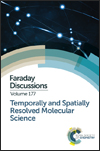Pluronic copolymer encapsulated SCR7 as a potential anticancer agent
Abstract
Nonhomologous end joining (NHEJ) of DNA double strand breaks (DSBs) inside cells can be selectively inhibited by 5,6-bis-(benzylideneamino)-2-mercaptopyrimidin-4-ol (SCR7) which possesses anticancer properties. The hydrophobicity of SCR7 decreases its bioavailability which is a major setback in the utilization of this compound as a therapeutic agent. In order to circumvent the drawback of SCR7, we prepared a polymer encapsulated form of SCR7. The physical interaction of SCR7 and Pluronic® copolymer is evident from different analytical techniques. The in vitro cytotoxicity of the drug formulations is established using the MTT assay.
- This article is part of the themed collection: Temporally and Spatially Resolved Molecular Science

 Please wait while we load your content...
Please wait while we load your content...